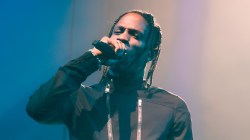While Hip Hop and basketball have often times traveled hand in hand, not much can be said for the legacy of basketball players on the mic. The Rap careers of Allen Iverson, Kobe Bryant, Shaquille O’Neal, and Ron Artest, although entertaining, sit firmly on the dusty and unreachable shelves of Hip Hop history. But the New York Knicks’ Amar’e Stoudemire has plans to try his luck with music, according to the New York Daily News.
The power forward recently appeared on the remake to the team’s theme song “Go New York Go,” which also features producer Swizz Beatz and teammate Carmelo Anthony. The Daily News reported that Stoudemire hopes to link up with Swizz once again, as well as with producer Lil Jon and Fabolous. He may release music before the NBA season begins in the fall.
In other news, producer Mahogany recently talked about selling his first beat to Jay-Z. As a newcomer, he explained, the success of Jay-Z helped to further his own career.
“The first track I sold went to Jay-Z for the [Streets is Watching Soundtrack],” he said. “I charged Jay $3,000, which is not a lot considering you have lawyer fees which can range between $500-$1,000. In my case it was $1,000, plus don’t forget management’s 20% commission, which left me with around $1,400, which Roc-A-fella only paid what’s called the first half advance. So we’re looking at $700 in my pocket.”

AD LOADING...
But the small amount of money quickly added up. “I received $150,000 in royalties, landed my first publishing deal with Windswept Pacific on the back end all within one year…not bad for a small upfront advance.” He talks about his first encounter with Dr. Dre here.
Lastly, Kool Herc counted out his top three old-school Hip Hop locations. The pioneering deejay cited The Twilight Zone and The Hevalo as two of his most cherished venues, as well as the birthplace of Hip Hop, The Recreation Room at 1520 Sedgwick Avenue.
“[Sedgwick Avenue] is the reference point for Hip Hop right there, without a doubt,” he told the Village Voice. “This is where it all started. It wasn’t a club, it was a recreation room for all the tenants in the building. They’d have birthday parties there, and tenants meetings and you could rent the room for $25. The set-up was a kitchen, two bathrooms, a coat-check room, and then the space and some chairs.”
He continued, “When I played there, people came through after the block party. It was a harmonious vibe. And it meant the end of house parties–after I started playing there it was no more house parties because this was more convenient.”



